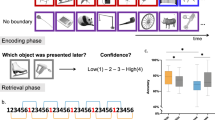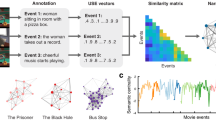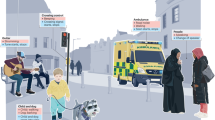Abstract
Our experience of the world seems to divide naturally into discrete, temporally extended events, yet the mechanisms underlying the learning and identification of events are poorly understood. Research on event perception has focused on transient elevations in predictive uncertainty or surprise as the primary signal driving event segmentation. We present human behavioral and functional magnetic resonance imaging (fMRI) evidence in favor of a different account, in which event representations coalesce around clusters or 'communities' of mutually predicting stimuli. Through parsing behavior, fMRI adaptation and multivoxel pattern analysis, we demonstrate the emergence of event representations in a domain containing such community structure, but in which transition probabilities (the basis of uncertainty and surprise) are uniform. We present a computational account of how the relevant representations might arise, proposing a direct connection between event learning and the learning of semantic categories.
This is a preview of subscription content, access via your institution
Access options
Subscription info for Japanese customers
We have a dedicated website for our Japanese customers. Please go to natureasia.com to subscribe to this journal.
Buy this article
- Purchase on SpringerLink
- Instant access to full article PDF
Prices may be subject to local taxes which are calculated during checkout






Similar content being viewed by others
References
Speer, N.K., Swallow, K.M. & Zacks, J.M. Activation of human motion processing areas during event perception. Cogn. Affect. Behav. Neurosci. 3, 335–345 (2003).
Newtson, D. Attribution and the unit of perception of ongoing behavior. J. Pers. Soc. Psychol. 28, 28–38 (1973).
Reynolds, J.R., Zacks, J.M. & Braver, T.S. A computational model of event segmentation from perceptual prediction. Cogn. Sci. 31, 613–643 (2007).
Baldwin, D., Andersson, A., Saffran, J. & Meyer, M. Segmenting dynamic human action via statistical structure. Cognition 106, 1382–1407 (2008).
Zacks, J.M., Kurby, C.A., Eisenberg, M.L. & Haroutunian, N. Prediction error associated with the perceptual segmentation of naturalistic events. J. Cogn. Neurosci. 23, 4057–4066 (2011).
Avrahami, J. & Kareev, Y. The emergence of events. Cognition 53, 239–261 (1994).
Saffran, J.R., Aslin, R.N. & Newport, E.L. Statistical learning by 8-month-old infants. Science 274, 1926–1928 (1996).
Rosch, E. & Mervis, C.B. Family resemblances: Studies in the internal structure of categories. Cognit. Psychol. 7, 573–605 (1976).
Medin, D.L. & Schaffer, M.M. Context theory of classification learning. Psychol. Rev. 85, 207–238 (1978).
Rogers, T.T. & McClelland, J.L. Semantic Cognition: A Parallel Distributed Processing Approach (MIT Press, Cambridge, Massachusetts, 2004).
Fortunato, S. Community detection in graphs. Phys. Rep. 486, 75–174 (2010).
Newman, M.E.J. The structure and function of complex networks. SIAM Rev. 45, 167–256 (2003).
Newman, M.E. Modularity and community structure in networks. Proc. Natl. Acad. Sci. USA 103, 8577–8582 (2006).
Girvan, M. & Newman, M.E. Community structure in social and biological networks. Proc. Natl. Acad. Sci. USA 99, 7821–7826 (2002).
Rosvall, M. & Bergstrom, C.T. Maps of random walks on complex networks reveal community structure. Proc. Natl. Acad. Sci. USA 105, 1118–1123 (2008).
Zacks, J.M. et al. Human brain activity time-locked to perceptual event boundaries. Nat. Neurosci. 4, 651–655 (2001).
Turk-Browne, N.B., Scholl, B.J. & Chun, M.M. Babies and brains: habituation in infant cognition and functional neuroimaging. Front. Hum. Neurosci 2, 16 (2008).
Grill-Spector, K., Henson, R. & Martin, A. Repetition and the brain: neural models of stimulus-specific effects. Trends Cogn. Sci. 10, 14–23 (2006).
Schapiro, A.C., Kustner, L.V. & Turk-Browne, N.B. Shaping of object representations in the human medial temporal lobe based on temporal regularities. Curr. Biol. 22, 1622–1627 (2012).
Press, C., Weiskopf, N. & Kilner, J.M. Dissociable roles of human inferior frontal gyrus during action execution and observation. Neuroimage 60, 1671–1677 (2012).
James, T.W. & Gauthier, I. Repetition-induced changes in BOLD response reflect accumulation of neural activity. Hum. Brain Mapp. 27, 37–46 (2006).
Turk-Browne, N.B., Yi, D.J., Leber, A.B. & Chun, M.M. Visual quality determines the direction of neural repetition effects. Cereb. Cortex 17, 425–433 (2007).
Thompson-Schill, S.L. Neuroimaging studies of semantic memory: inferring “how” from “where”. Neuropsychologia 41, 280–292 (2003).
Moss, H.E. et al. Selecting among competing alternatives: selection and retrieval in the left inferior frontal gyrus. Cereb. Cortex 15, 1723–1735 (2005).
Vandenberghe, R., Price, C., Wise, R., Josephs, O. & Frackowiak, R.S. Functional anatomy of a common semantic system for words and pictures. Nature 383, 254–256 (1996).
Homae, F., Hashimoto, R., Nakajima, K., Miyashita, Y. & Sakai, K.L. From perception to sentence comprehension: the convergence of auditory and visual information of language in the left inferior frontal cortex. Neuroimage 16, 883–900 (2002).
Ueno, T., Saito, S., Rogers, T.T. & Lambon Ralph, M.A. Lichtheim 2: synthesizing aphasia and the neural basis of language in a neurocomputational model of the dual dorsal-ventral language pathways. Neuron 72, 385–396 (2011).
Petersson, K.M., Forkstam, C. & Ingvar, M. Artificial syntactic violations activate Broca's region. Cogn. Sci. 28, 383–407 (2004).
Bornkessel, I., Zysset, S., Friederici, A.D., von Cramon, D.Y. & Schlesewsky, M. Who did what to whom? The neural basis of argument hierarchies during language comprehension. Neuroimage 26, 221–233 (2005).
Gelfand, J.R. & Bookheimer, S.Y. Dissociating neural mechanisms of temporal sequencing and processing phonemes. Neuron 38, 831–842 (2003).
Sridharan, D., Levitin, D.J., Chafe, C.H., Berger, J. & Menon, V. Neural dynamics of event segmentation in music: converging evidence for dissociable ventral and dorsal networks. Neuron 55, 521–532 (2007).
Kilner, J.M., Neal, A., Weiskopf, N., Friston, K.J. & Frith, C.D. Evidence of mirror neurons in human inferior frontal gyrus. J. Neurosci. 29, 10153–10159 (2009).
Bar, M., Aminoff, E., Mason, M. & Fenske, M. The units of thought. Hippocampus 17, 420–428 (2007).
Ezzyat, Y. & Davachi, L. What constitutes an episode in episodic memory? Psychol. Sci. 22, 243–252 (2011).
Koechlin, E., Corrado, G., Pietrini, P. & Grafman, J. Dissociating the role of the medial and lateral anterior prefrontal cortex in human planning. Proc. Natl. Acad. Sci. USA 97, 7651–7656 (2000).
Wood, J.N., Knutson, K.M. & Grafman, J. Psychological structure and neural correlates of event knowledge. Cereb. Cortex 15, 1155–1161 (2005).
Krueger, F. et al. The frontopolar cortex mediates event knowledge complexity: a parametric functional MRI study. Neuroreport 20, 1093–1097 (2009).
Addis, D.R., Wong, A.T. & Schacter, D.L. Remembering the past and imagining the future: common and distinct neural substrates during event construction and elaboration. Neuropsychologia 45, 1363–1377 (2007).
Elman, J.L. Finding structure in time. Cogn. Sci. 14, 179–211 (1990).
Cleeremans, A. & McClelland, J.L. Learning the structure of event sequences. J. Exp. Psychol. Gen. 120, 235–253 (1991).
Landauer, T.K. & Dumais, S.T. A solution to Plato's problem: the latent semantic analysis theory of acquisition, induction, and representation of knowledge. Psychol. Rev. 104, 211–240 (1997).
Griffiths, T.L., Steyvers, M. & Tenenbaum, J.B. Topics in semantic representation. Psychol. Rev. 114, 211–244 (2007).
Howard, M.W., Shankar, K.H. & Jagadisan, U.K.K. Constructing semantic representations from a gradually changing representation of temporal context. Top. Cogn. Sci. 3, 48–73 (2011).
Fiser, J. & Aslin, R.N. Statistical learning of higher-order temporal structure from visual shape sequences. J. Exp. Psychol. Learn. Mem. Cogn. 28, 458–467 (2002).
Pothos, E.M. Theories of artificial grammar learning. Psychol. Bull. 133, 227–244 (2007).
Remillard, G. Implicit learning of fifth- and sixth-order sequential probabilities. Mem. Cognit. 38, 905–915 (2010).
Perruchet, P., Vinter, A., Pacteau, C. & Gallego, J. The formation of structurally relevant units in artificial grammar learning. Q. J. Exp. Psychol. A 55, 485–503 (2002).
Perruchet, P. & Vinter, A. Parser: a model for word segmentation. J. Mem. Lang. 39, 246–263 (1998).
Botvinick, M. & Plaut, D.C. Doing without schema hierarchies: a recurrent connectionist approach to normal and impaired routine sequential action. Psychol. Rev. 111, 395–429 (2004).
Baird, J.A. & Baldwin, D.A. Making sense of human behavior: Action parsing and intentional inference. in Intentions and Intentionality: Foundations of Social Cognition (eds. B.F. Malle, L.J. Moses & D.A. Baldwin) 193–206 (MIT Press, Cambridge, Massachusetts, 2001).
Pereira, F. & Botvinick, M. Information mapping with pattern classifiers: a comparative study. Neuroimage 56, 476–496 (2011).
Acknowledgements
We thank M. Arcaro, J. McGuire, K. Norman, F. Pereira and M. Todd for helpful discussions. This project was made possible through the support of a grant from the John Templeton Foundation. The opinions expressed in this publication are those of the authors and do not necessarily reflect the views of the John Templeton Foundation. This work was also supported by US National Science Foundation Graduate Research Fellowship DGE-0646086 to A.C.S., US National Institutes of Health grant R01-EY021755 to N.B.T.-B., and US National Science Foundation grant IIS-1207833 and a James S. McDonnell Foundation grant to M.M.B.
Author information
Authors and Affiliations
Contributions
A.C.S., T.T.R. and M.M.B. designed the experiments. A.C.S. and N.I.C. collected and analyzed the data. N.B.T.-B. provided guidance on data acquisition and analysis. A.C.S., T.T.R., M.M.B. and N.B.T.-B. wrote the paper. All of the authors discussed the results and commented on the manuscript.
Corresponding author
Ethics declarations
Competing interests
The authors declare no competing financial interests.
Supplementary information
Supplementary Text and Figures
Supplementary Figures 1–5 and Supplementary Tables 1 and 2 (PDF 3341 kb)
Rights and permissions
About this article
Cite this article
Schapiro, A., Rogers, T., Cordova, N. et al. Neural representations of events arise from temporal community structure. Nat Neurosci 16, 486–492 (2013). https://doi.org/10.1038/nn.3331
Received:
Accepted:
Published:
Issue Date:
DOI: https://doi.org/10.1038/nn.3331
This article is cited by
-
MarkBot – A Language Model-Driven Chatbot for Interactive Marketing in Post-Modern World
Information Systems Frontiers (2024)
-
Visuospatial information foraging describes search behavior in learning latent environmental features
Scientific Reports (2023)
-
Changes in statistical learning across development
Nature Reviews Psychology (2023)
-
Hippocampal spatio-predictive cognitive maps adaptively guide reward generalization
Nature Neuroscience (2023)
-
Predicting memory from the network structure of naturalistic events
Nature Communications (2022)



